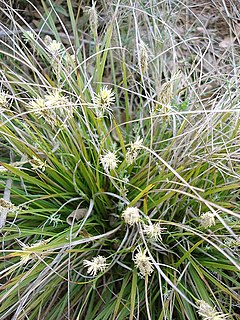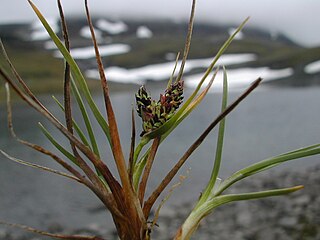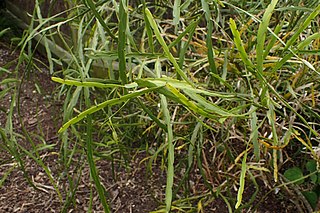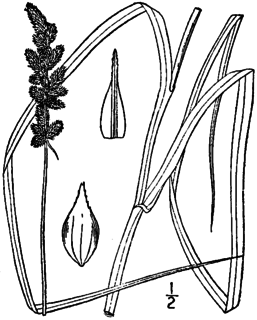
The Cyperaceae are a family of graminoid (grass-like), monocotyledonous flowering plants known as sedges. The family is large, with some 5,500 known species described in about 90 genera, the largest being the "true sedges" genus Carex with over 2,000 species.
This gallery of sovereign state flags shows the national or state flags of sovereign states that appear on the list of sovereign states. For other flags, please see flags of active autonomist and secessionist movements, flags of extinct states and gallery of flags of dependent territories. Each flag is depicted as if the flagpole is positioned on the left of the flag, except for those of Iran, Iraq and Saudi Arabia which are depicted with the hoist to the right.

Carex is a vast genus of more than 2,000 species of grass-like plants in the family Cyperaceae, commonly known as sedges. Other members of the family Cyperaceae are also called sedges, however those of genus Carex may be called true sedges, and it is the most species-rich genus in the family. The study of Carex is known as caricology.

Deoxyepinephrine, also known by the common names N-methyldopamine and epinine, is an organic compound and natural product that is structurally related to the important neurotransmitters dopamine and epinephrine. All three of these compounds also belong to the catecholamine family. The pharmacology of epinine largely resembles that of its "parent", dopamine. Epinine has been found in plants, insects and animals. It is also of significance as the active metabolic breakdown product of the prodrug ibopamine, which has been used to treat congestive heart failure.

Lophophora is a genus of spineless, button-like cacti native to Texas from Presidio county south right along the Rio Grande river to Starr County, Texas. Its range continues south through Northeast and north central Mexico to Querétaro in central Mexico. The species are extremely slow growing, sometimes taking up to thirty years to reach flowering age in the wild. Cultivated specimens grow considerably faster, usually taking between three and ten years to reach from seedling to mature flowering adult. The slow rate of reproduction and over-harvesting by collectors render the species under threat in the wild.

The peyote, scientific name Lophophora williamsii, is a small, spineless cactus with psychoactive alkaloids, particularly mescaline. Peyote is a Spanish word derived from the Nahuatl peyōtl[ˈpejoːt͡ɬ], meaning "caterpillar cocoon", from a root peyōni, "to glisten". Peyote is native to Mexico and southwestern Texas. It is found primarily in the Sierra Madre Occidental, the Chihuahuan Desert and in the states of Nayarit, Coahuila, Nuevo León, Tamaulipas, and San Luis Potosí among scrub. It flowers from March to May, and sometimes as late as September. The flowers are pink, with thigmotactic anthers.

Carex vesicaria is an essentially Holarctic species of sedge known as bladder sedge, inflated sedge, and blister sedge. It has been used to insulate footwear in Norway and among the Sami people, and for basketry in North America.
Many cacti are known to be psychoactive, containing phenethylamine alkaloids such as mescaline. However, the two main ritualistic (folkloric) genera are Echinopsis, of which the most psychoactive species is the San Pedro cactus, and Lophophora, with peyote being the most psychoactive species. Several other species pertaining to other genera are also psychoactive, though not always used with a ritualistic intent.
Kenneth Kent Mackenzie (1877–1934) was a lawyer and amateur botanist who wrote extensively on the genus Carex in North America. The standard author abbreviation Mack. is used to indicate this person as the author when citing a botanical name.

Carex hirta, the hairy sedge or hammer sedge, is a species of sedge native across Europe. It has characteristic hairy leaves and inflorescences, and is the type species of the genus Carex.

Carex rufina is a species of sedge known by the common name snowbed sedge. It is native to Denmark, Norway, Sweden, Greenland, and northeastern Canada.

Carex cryptolepis, known as northeastern sedge, is a North American species of sedge first described by Kenneth Mackenzie in 1914.

Carmichaelia williamsii is a species of pea in the family Fabaceae. It is found only in the North Island of New Zealand. Its conservation status (2018) is "At Risk (relict)" under the New Zealand Threat Classification System.

Carex annectens, sometimes called yellow-fruited fox sedge, is a species of sedge native to most of the eastern United States and southeastern Canada. It is common in prairies and high-water table fallow fields. In the Chicago area, its coefficient of conservatism is 3, and in Michigan, it is only 1, indicating its relatively low fidelity to high quality habitats.

Carex juniperorum, the juniper sedge, is a perennial flowering plant native to North America, first described by botanist William J. Crins in 1993. C. juniperorum is in the Cyperaceae (sedge) family, and is closely related to C. jamesii and C. willdenowii. It is commonly called juniper sedge as it is often seen growing in areas with red cedar, though the presence of cedar is not necessarily a requirement for it to grow.

Carex bicolor, the bicoloured sedge, is a species of sedge native to North America, Northern Europe and Northern Asia. The International Union for Conservation of Nature has assessed the plant's conservation status as being of least concern because it has a widespread distribution and faces no particular threats.
Peter William Ball is an English-born botanist, plant collector, and plant taxonomist, specializing in caricology.











